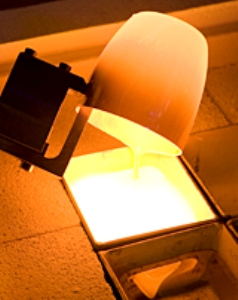Scientists at Fraunhofer Institute have for the first time, introduced a for developing and examining glass. The robot will be involved in developing new kinds of glass and also conduct a thorough examination of its properties. The robot will be showcased at the “productronica” trade fair which will be held at Munich, Germany from 15 to 18 November.
 robot for glass development
robot for glass development
Researchers working on developing new types of glass usually choose around 10 compounds, which are potential elements for developing glass. These elements are heated in a furnace and then poured into a mould. The mixture is then allowed to cool down to room temperature. During the cooling process the researchers take samples of the viscous glass and study its properties. The whole exercise of sample study and testing needs two weeks of time for a single employee to test 16 samples. The scientists from the Fraunhofer Institute have designed a robot, which they claim can automatically conduct the sampling procedures and takes merely one day to process 16 samples. With the help of the robot, the development and the testing of glass takes place much faster and in a more cost-effective fashion.
The central part of the robot carries out the task of placing a mixing cup on a scale and moving it under 14 storage vessels. A pre-determined amount of the powder is filled into the storage cups. After filling the cups the robot closes the top and evenly mixes the ingredients. The next step is to fill the mixture into a crucible and subject it to heat by putting it into any of the furnaces. This step is repeated many times to ensure that the gases that emerge out of the heating process do not form foam. Once the glass becomes viscous, the robot removes the crucible from fire and transfers the viscous liquid into another mould and stacks it in a stress relieving furnace to cool down to room temperature. Now the robot proceeds with the analysis of glass by following the thermo-optical measurement principle. The sample is compared by looking at two measurement windows and the shades of the sample are recorded in a CCD camera. The changes in the shape and colour reveal the characteristics of glass.